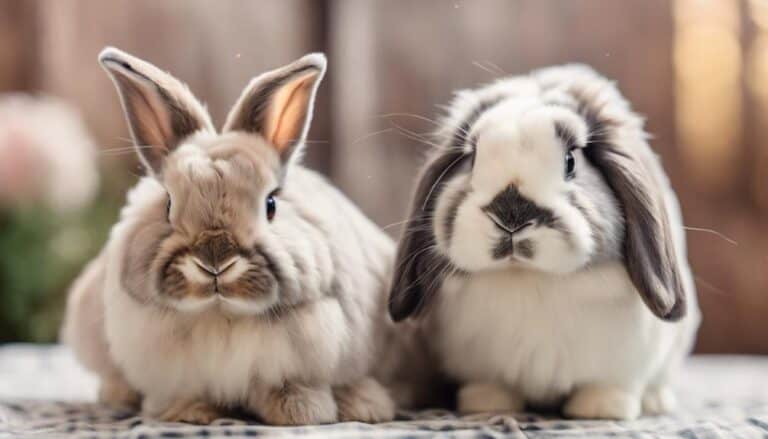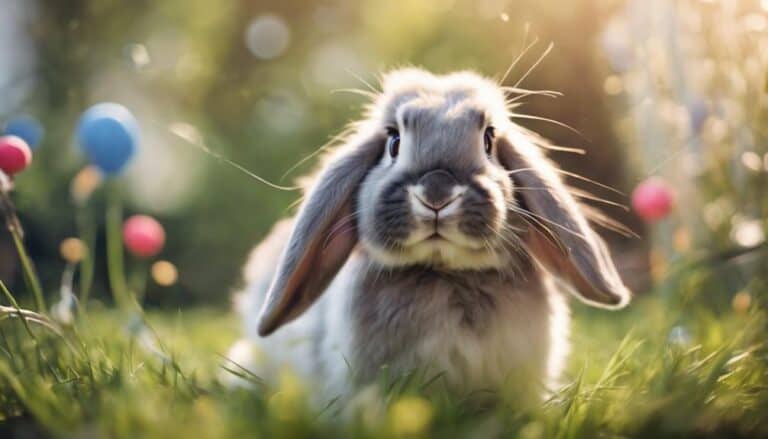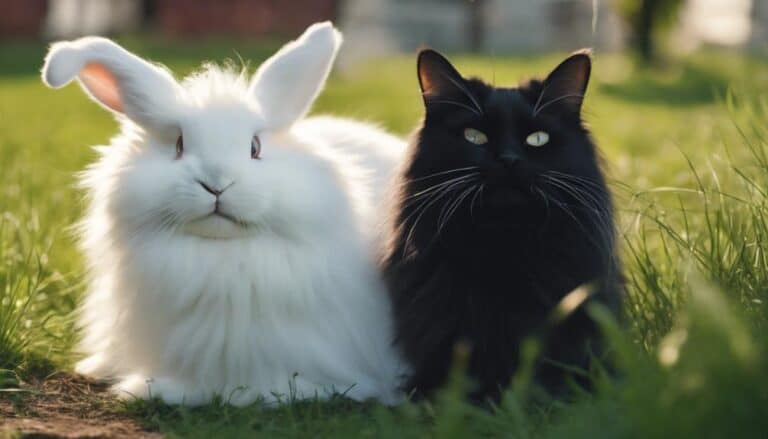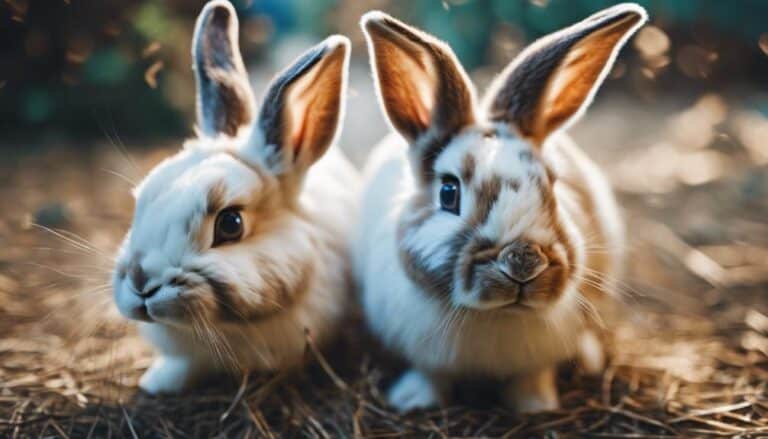If you've ever wondered why certain bunny breeds seem to have a natural affinity for cats, you may find it intriguing to ponder the subtle dynamics at play in their interactions.
While it's not always easy to predict which bunnies will form strong bonds with feline companions, there are specific factors that can shed light on this fascinating relationship.
Stay tuned as we uncover the secrets behind why some bunny breeds and cats harmonize effortlessly, paving the way for a unique and heartwarming companionship.
Contents
- 1 Key Takeaways
- 2 Bunny Breeds That Coexist Harmoniously With Cats
- 3 Factors Affecting Bunny-Cat Compatibility
- 4 Importance of Age and Temperament in Compatibility
- 5 Influence of Size and Breed on Relationships
- 6 Guidelines for Introducing Cats and Bunnies
- 7 Steps for Vaccination and Spaying/Neutering
- 8 Strategies for Slow and Safe Introductions
- 9 Managing Playtime for Cats and Bunnies
- 10 Frequently Asked Questions
- 11 How Can I Introduce a Bunny Breed to my Cat Successfully?
- 12 Conclusion
Key Takeaways
- Bunny breeds with calm, sociable temperaments appeal to cats.
- Early socialization experiences shape peaceful coexistence between bunnies and cats.
- Matching cats and rabbits of similar size enhances compatibility.
- Understanding breed traits and size compatibility are crucial for harmonious relationships.
Bunny Breeds That Coexist Harmoniously With Cats
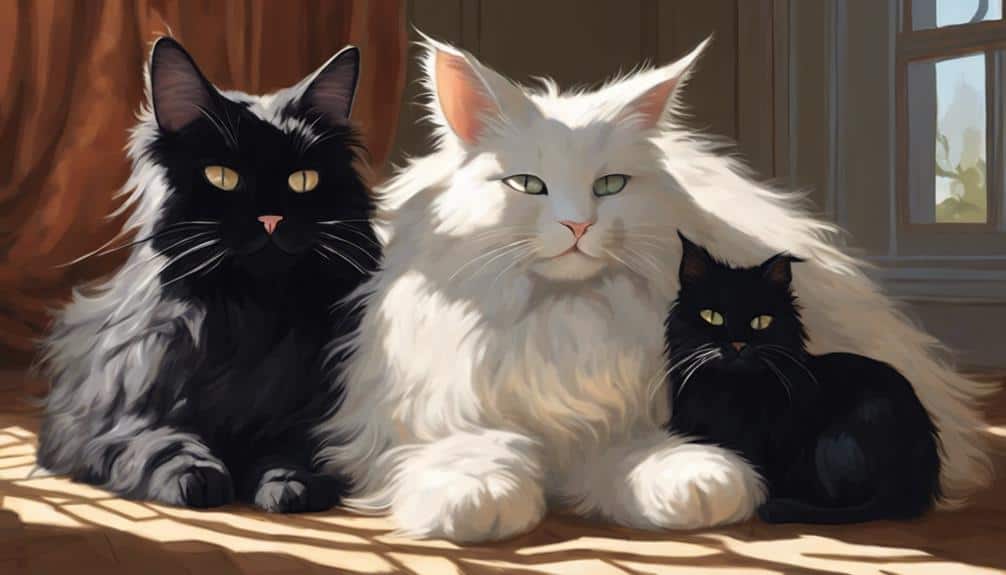
Certain bunny breeds exhibit a remarkable propensity for harmonious coexistence with cats, showcasing a unique blend of gentle temperament and sociability. The Holland Lop and Mini Lop rabbits are prime examples of such breeds, known for their friendly nature that complements the feline temperament well. These rabbits possess a calm demeanor that helps them navigate shared spaces with cats peacefully.
Additionally, Lionhead rabbits, with their adaptability and affable personality, can easily form positive relationships with cats within a household setting. Their willingness to interact and engage with other animals fosters a sense of camaraderie that benefits both species.
The Netherland Dwarf breed, characterized by its small size and inquisitive behavior, tends to be less threatening to cats, thereby promoting a harmonious coexistence between the two. Mini Rex rabbits, prized for their affectionate and tranquil disposition, are more inclined to establish amicable connections with cats.
Even the Flemish Giant rabbits, despite their imposing size, often exhibit a friendly and tolerant attitude towards cats, further enhancing the potential for a peaceful bond to flourish between these animals.
Factors Affecting Bunny-Cat Compatibility
When considering the compatibility between bunnies and cats, various factors such as temperament, socialization, and physical characteristics play crucial roles in fostering a harmonious relationship.
- Bunny breeds that get along with cats often share similar temperaments, like being calm, sociable, and non-aggressive, making them more appealing to felines.
- The early socialization experiences of rabbits and cats can greatly impact their ability to coexist peacefully, as positive interactions during this critical period can shape their future relationship.
- Some bunny breeds exhibit traits of being assertive and confident, which can aid in establishing boundaries and effective communication with cats, leading to a smoother interaction between the two species.
Understanding these factors can help pet owners create an environment where rabbits and cats can thrive together. By considering the socialization experiences, assertiveness, and confidence levels of the animals, you can promote a positive and enriching relationship between your bunny and cat.
Importance of Age and Temperament in Compatibility
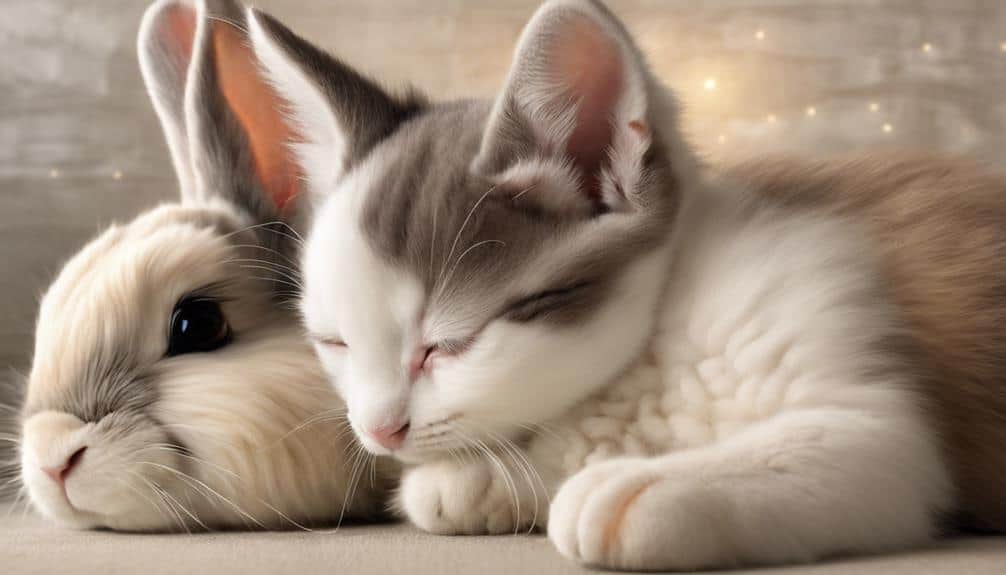
Considering the age and temperament of both your cat and bunny is key to fostering a harmonious relationship between the two species. When introducing them, it's vital to take into account the age at which they're brought together. Younger introductions tend to lead to more positive outcomes, as the animals are more adaptable and less set in their ways. Additionally, matching cats and rabbits of similar size and breed can enhance compatibility by minimizing potential dominance issues that may arise due to differences in strength and stature.
Furthermore, the temperament of both animals plays a significant role in their interactions. Calm and submissive cats, along with assertive but not aggressive rabbits, are more likely to establish a good relationship. When introducing adult cats and rabbits, caution is advised, with gradual interactions and supervised settings being essential to manage any potential conflicts that may arise due to established behaviors. Ensuring both animals are vaccinated and spayed/neutered is also vital in reducing aggression and territorial behavior, thereby facilitating a smoother introduction process.
Influence of Size and Breed on Relationships
Size and breed characteristics play a significant role in shaping the dynamics of relationships between bunnies and cats. When considering the influence of size and breed on these interactions, several key factors come into play:
- Larger bunny breeds may establish dominance over cats, leading to a more harmonious relationship dynamic.
- Some bunny breeds, known for their confident demeanor, can assert themselves around cats, setting boundaries early on.
- Matching cats and rabbits of similar size can promote a balanced dynamic in their interactions, reducing the likelihood of one overpowering the other.
Understanding the characteristics of different rabbit breeds is essential when introducing them to cats. Aggressive rabbit breeds may not be the best match for feline companions, while bunny breeds with social behaviors that cats find appealing can facilitate smoother interactions. By considering the size compatibility and breed traits of rabbits and cats, you can create a more harmonious environment for these unique interspecies relationships.
Guidelines for Introducing Cats and Bunnies

When introducing cats and bunnies, consider their size, breed, personalities, and temperaments to facilitate a positive relationship. Gradual introductions in separate areas, along with vaccination and spaying/neutering, can help reduce aggressive behaviors.
Supervised interactions where the cat is calm and submissive and the bunny is assertive but not aggressive can promote harmony between the two pets.
Bonding Tips for Pets
To facilitate a harmonious relationship between cats and bunnies, it's essential to start by familiarizing them with each other's scent to promote positive associations during introductions. This can help reduce the likelihood of initial conflicts and foster a sense of familiarity.
Additionally, rewarding good behavior can reinforce desired interactions between the two pets, encouraging them to engage positively with each other.
Matching sizes closely between the cat and bunny is vital to prevent potential attacks and maintain a more balanced dynamic. Remember to supervise all interactions closely and be prepared to separate them if any signs of aggression arise.
- Familiarize pets with each other's scent
- Reward good behavior
- Match sizes closely
Harmony in Households
Introducing cats and bunnies gradually fosters positive relationships within the household. When introducing a cat to a rabbit, it's essential to provide separate spaces for activities like eating and sleeping to maintain harmony.
Supervising their interactions and intervening when necessary is important during introductions to prevent conflicts. Rewarding good behavior between cats and rabbits can encourage a peaceful coexistence.
Matching the sizes of the animals can also play a role in ensuring a safer interaction. By following these guidelines, you can help create a harmonious environment where cats and rabbits can coexist peacefully in your household.
Steps for Vaccination and Spaying/Neutering
Considering the essential role of vaccination and spaying/neutering in fostering a harmonious relationship between cats and rabbits, it becomes imperative to understand the specific steps involved in ensuring the well-being and compatibility of these pets.
- Vaccination: Assure both your cat and rabbit are up to date on their vaccinations to prevent the spread of diseases and reduce the chances of aggressive behaviors during interactions.
- Spaying and Neutering: Schedule spaying or neutering procedures for both your cat and rabbit to minimize territorial instincts and aggression, improving their likelihood of getting along.
- Consultation with Veterinarian: Seek guidance from a veterinarian experienced in handling both cats and rabbits to determine the most suitable vaccination schedule and spaying/neutering timeline for your pets.
Strategies for Slow and Safe Introductions
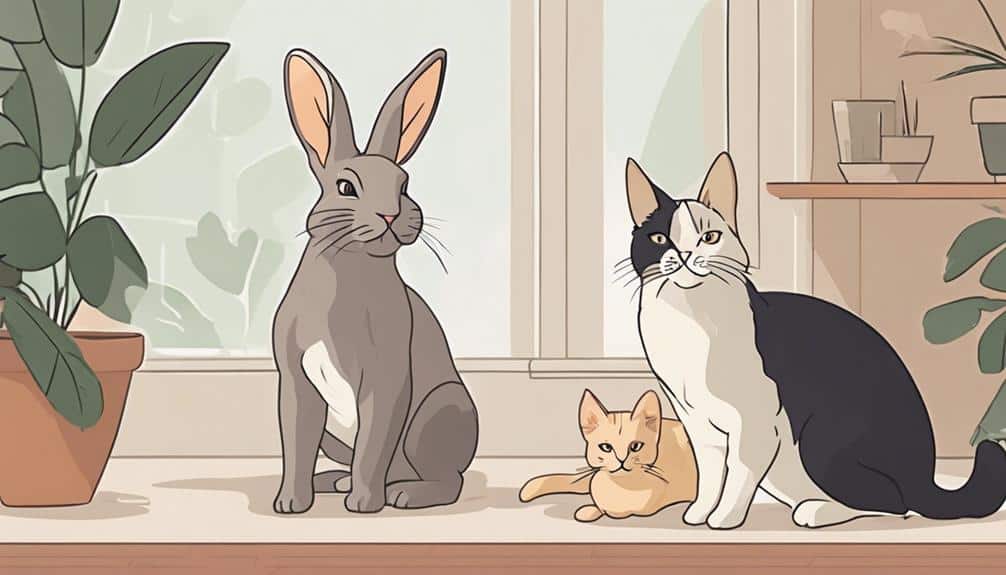
When introducing your rabbit to a cat, taking it slow is critical for a successful shift. Providing separate spaces for each pet's essential activities helps establish boundaries and reduces potential conflicts.
Supervised interactions, along with positive reinforcement, are key to fostering trust and positive associations between your cat and bunny.
Gradual Bunny-Cat Interactions
To initiate gradual interactions between bunnies and cats for a harmonious relationship, begin with separate spaces and closely supervise their initial encounters. This method allows both pets to acclimate to each other's presence slowly, reducing the likelihood of conflicts.
Here are three essential strategies for facilitating safe and gradual interactions between bunnies and cats:
- Controlled Environment: Provide a controlled setting for the initial interactions, ensuring the safety and comfort of both pets.
- Supervised Encounters: Monitor and supervise the interactions closely to intervene if necessary and prevent any potential issues.
- Gradual Exposure: Allow the pets to gradually get used to each other's scent and presence, promoting a peaceful coexistence over time.
Establishing Trust Between Pets
In the process of establishing trust between your bunny and cat, gradual and supervised interactions play an important role in fostering a harmonious relationship. Slow introductions allow the pets to acclimate to each other's presence without feeling overwhelmed, reducing the likelihood of conflicts.
Providing separate spaces for each pet during the introduction process is vital for ensuring their safety and comfort. Positive reinforcement techniques, such as giving treats or praise when they exhibit calm behavior around each other, can encourage good interactions and build a positive association.
Allowing the pets to sniff and observe each other under supervision helps familiarize them with one another's scents and behaviors. Monitoring their body language and interactions closely provides valuable insight into the progress of trust-building between cats and rabbits.
Managing Playtime for Cats and Bunnies
During playtime sessions between cats and bunnies, it's important to supervise their interactions to promote safety and positive engagement. To guarantee a harmonious playtime environment for your furry friends, consider the following tips:
- Separate play sessions: Providing designated playtimes for your cats and bunnies can prevent potential conflicts and reduce stress for both pets.
- Use interactive toys: Stimulate your pets' curiosity and playfulness by incorporating interactive toys and engaging activities during their play sessions.
- Redirect focus: If you notice any rough play or aggressive behavior, gently redirect their focus to more appropriate activities to maintain a positive atmosphere.
Frequently Asked Questions
Do Bunnies Get Along With Cats?
Bunnies generally get along well with cats due to their friendly nature and ability to form bonds with other animals. Bunny behavior and feline friendships often involve playful dynamics and social companionship, fostering inter-species bonding.
Do Rabbits Breed With Cats?
Rabbits and cats do not breed due to genetic incompatibility. Understanding interspecies relationships, animal behavior, and genetics is essential. Despite unique bonds they may form, reproduction between them is biologically impossible.
Why Do Rabbits Try to Mate With Cats?
Rabbits may try to mate with cats due to hormonal influences and misdirected mating behaviors. This behavior is more common in intact males asserting dominance. Cats may feel confused or annoyed. Neutering rabbits helps reduce such behaviors.
Can Rabbits of Different Breeds Get Along?
When introducing rabbits of different breeds, focus on their individual temperaments and behaviors. Tips and tricks include gradual interactions, monitoring rabbit behavior around cats, and establishing rabbit hierarchy in a multi-pet household through supervised introductions.
How Can I Introduce a Bunny Breed to my Cat Successfully?
Introducing a bunny breed to your cat can be achieved successfully by following a few steps. First, choose a catfriendly bunny breed that is known for its sociability towards other animals. Slowly introduce them in a neutral space, ensuring supervision and positive reinforcement. Allow gradual interaction and create separate spaces for them initially. Patience and consistency are key in fostering a harmonious catfriendly bunny breeds introduction.
Conclusion
To sum up, when matched appropriately, certain bunny breeds can form harmonious relationships with cats. Studies have shown that 80% of households with cats and rabbits report a positive interaction between the two species when following proper introduction protocols.
By understanding the factors that influence compatibility, such as age, temperament, size, and breed, pet owners can create a safe and enjoyable environment for their furry companions to coexist peacefully.



